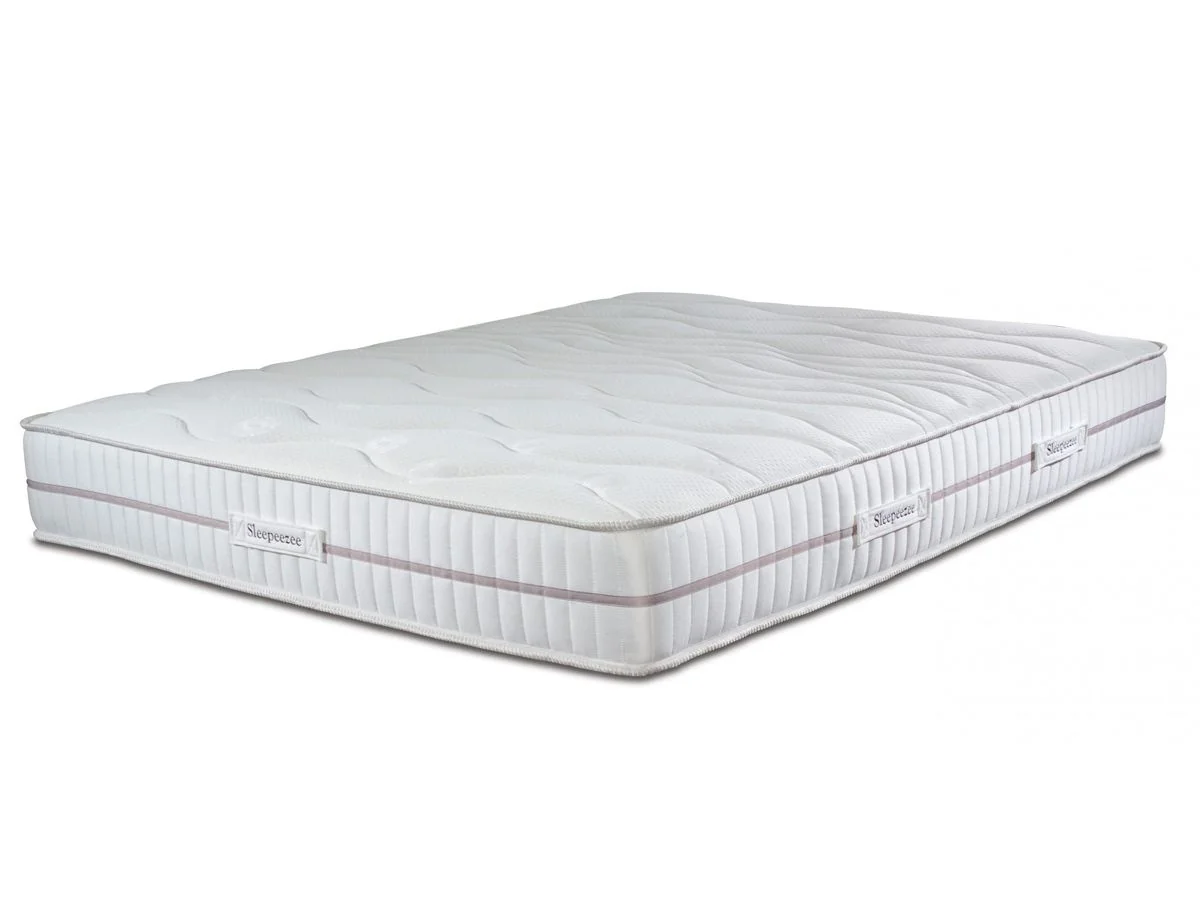Sleep Talk Blog, Sleep Issues, Product Help, Health & Wellbeing
Best Mattress For a Herniated Disc
Table of Contents
A herniated disc can affect any region of your spine, whether it's the upper (cervical), middle (thoracic), or lower (lumbar) back. Regardless of the location, selecting an appropriate mattress that provides deep and consistent pressure relief is absolutely crucial for managing your condition and ensuring restful sleep.
Pressure relief in a mattress plays a vital role in managing herniated disc discomfort by effectively distributing body weight across the sleeping surface. This even distribution helps prevent the concentration of pressure on specific points, which can exacerbate pain and discomfort.
The last thing you want with a herniated disc is a mattress that creates dips or valleys under your body weight, as these irregularities can significantly increase stress on your already sensitive spine and potentially worsen your condition.
While there haven't been specific clinical studies focusing on the relationship between herniated discs and different mattress types, medical professionals and sleep experts generally agree that memory foam and latex foam mattresses are the most beneficial for managing back pain.

These materials, whether in pure foam form or incorporated into hybrid designs with a substantial foam layer, have consistently demonstrated superior comfort and support for individuals with back conditions.
However, it's essential to understand that the mattress material represents only half of the equation when it comes to achieving optimal sleep comfort.
The other crucial factor is selecting a mattress with the appropriate firmness level that aligns with your recommended sleeping position. This balance between material and firmness is fundamental in creating the ideal sleep environment for someone with a herniated disc.
This comprehensive article delves into all the essential aspects you need to consider when choosing a mattress while dealing with a herniated disc, ensuring you can make an informed decision for a more comfortable and restorative night's sleep.
Mattress types and materials for a herniated disc
When you're dealing with a herniated disc, your spine becomes particularly sensitive to movement and pressure changes. This increased sensitivity means you need a mattress that excels at motion isolation, ensuring that you remain comfortable and undisturbed when either you or your sleep partner shifts position during the night.

For achieving optimal motion isolation, pure foam mattresses stand out as the premier choice – specifically those made from memory foam or latex foam. These materials are exceptional at absorbing and dissipating energy, preventing movement from transferring across the mattress surface.
This characteristic is particularly beneficial for individuals with herniated discs who need to minimise any potential disruption to their spine during sleep.
Memory foam mattresses prove especially beneficial for herniated disc sufferers due to their unique properties. They excel at absorbing impacts and releasing energy gradually, resulting in a sleeping surface with minimal bounce or spring effect.
This slow-response characteristic helps maintain spinal alignment and reduces the likelihood of sudden movements that could trigger pain. Latex foam, while sharing many benefits with memory foam, offers a slightly different feel.
It provides more responsiveness than memory foam, which can improve ease of movement when changing positions. Additionally, latex typically offers a firmer feel, which might be particularly advantageous if you prefer or need to sleep on your back.
Hybrid mattresses can also be a viable option for those with herniated discs, provided they feature a substantial memory foam comfort layer. Ideally, this layer should be at least 3cm thick to ensure effective motion isolation. The combination of supportive springs and pressure-relieving foam can offer a balanced sleep surface that addresses multiple needs.

Mattress firmness ratings for a herniated disc
When dealing with a herniated disc, sleeping on your back is typically recommended as the optimal position as it helps maintain proper spinal alignment. For back sleepers, a medium-firm mattress often provides the best balance of comfort and support, though the ideal firmness level can vary significantly based on your body weight.
For individuals weighing up to 175lbs (approximately 79kg), medium firmness mattresses typically offer the most appropriate level of support and comfort.
Those weighing up to 230lbs (approximately 104kg) generally benefit more from medium-firm mattresses, as the additional firmness provides enhanced support for their body weight while maintaining proper spinal alignment.
If you find yourself more comfortable sleeping on your side, which some people with herniated discs do, a medium firmness mattress might be more suitable for your needs.
The slightly softer surface helps accommodate the natural curves of your body when side-sleeping, effectively reducing pressure points along your shoulders and hips while still maintaining adequate support for your spine.
It's crucial to understand that mattress firmness is a relative concept that varies based on individual factors, particularly body weight. For instance, what feels like a medium-firm mattress to someone of a higher weight might feel significantly firmer to someone lighter.
Conversely, a medium-soft mattress might feel adequately firm to a person of lower weight but too soft for someone heavier. For a more detailed exploration of this topic, our comprehensive mattress firmness guide provides in-depth information to help you make the most informed decision.

While investing in a suitable mattress forms the foundation for better sleep with a herniated disc, there are numerous additional strategies and modifications you can implement to significantly enhance your sleep quality and manage discomfort effectively.
Here are comprehensive tips from our sleep experts to help you create an optimal sleeping environment:
- Consider elevating your bed frame height to facilitate easier bed entry and exit. A higher bed frame reduces the strain on your back during these transitions, minimising the risk of aggravating your herniated disc. Aim for a height where your feet can comfortably touch the ground when seated on the edge.
- Adopt a back-sleeping position as your primary sleep posture. This position helps maintain natural spinal alignment and significantly reduces the likelihood of nerve compression. Place a small pillow under your knees to further support the natural curve of your spine and relieve pressure on your lower back.
- Select one firm, supportive pillow that maintains proper cervical alignment. Multiple pillows or overly soft options can create awkward angles, potentially exacerbating your condition. The ideal pillow should keep your head and neck in a neutral position, aligned with your spine.
- For side sleeping, proper positioning is crucial. Place a firm pillow between your knees to maintain optimal hip and spine alignment. This helps distribute pressure evenly and prevents your upper leg from pulling your spine out of alignment. Consider using a body pillow for additional support along your entire side.
- Incorporate therapeutic heat elements into your bed setup. Options include specialised heated mattress toppers, electric blankets, or traditional hot water bottles. Heat therapy can help relax tense muscles, increase blood flow to the affected area, and provide natural pain relief before sleep.
- Utilise topical pain relief solutions such as ibuprofen gel directly on the affected area. These treatments can provide localised pain management without the systemic effects of oral medications. Apply the gel approximately 30 minutes before bedtime for optimal effectiveness.
- Time your pain medication strategically. If using oral pain relievers like ibuprofen or paracetamol, take them approximately one hour before your planned bedtime. This allows the medication to reach peak effectiveness when you're trying to fall asleep.
- Communicate with your sleep partner about movement considerations. Request gentle, mindful movements when entering or leaving the bed to minimise mattress disturbance. Consider using a mattress with good motion isolation properties to further reduce movement transfer.
- Establish and maintain a consistent sleep schedule. This is particularly crucial during recovery periods or when dealing with sleep disruptions due to pain. A regular routine helps regulate your body's internal clock and can improve sleep quality over time.
Final thoughts
Managing sleep with a herniated disc presents significant challenges, but implementing the right combination of supportive equipment and sleep strategies can make a substantial difference in your comfort levels and sleep quality.
While a high-quality mattress serves as the cornerstone of better sleep, the complementary measures discussed above can enhance your overall sleep experience.
Don't hesitate to experiment with different sleeping positions within the recommended guidelines. Your body's comfort preferences may vary from day to day, and it's important to respond to these changing needs.
Listen to your body's signals and adjust your position accordingly, always prioritising positions that minimise pain and promote proper spinal alignment.
Remember that severe or persistent pain that significantly impacts your sleep requires professional medical attention.
Your GP remains the most reliable resource for managing chronic pain and sleep disruptions related to your herniated disc.
They can provide personalised medical advice, explore additional treatment options, and potentially recommend specialist consultations if necessary. Don't hesitate to schedule an appointment if conservative measures aren't providing adequate relief for your sleep-disrupting pain.

